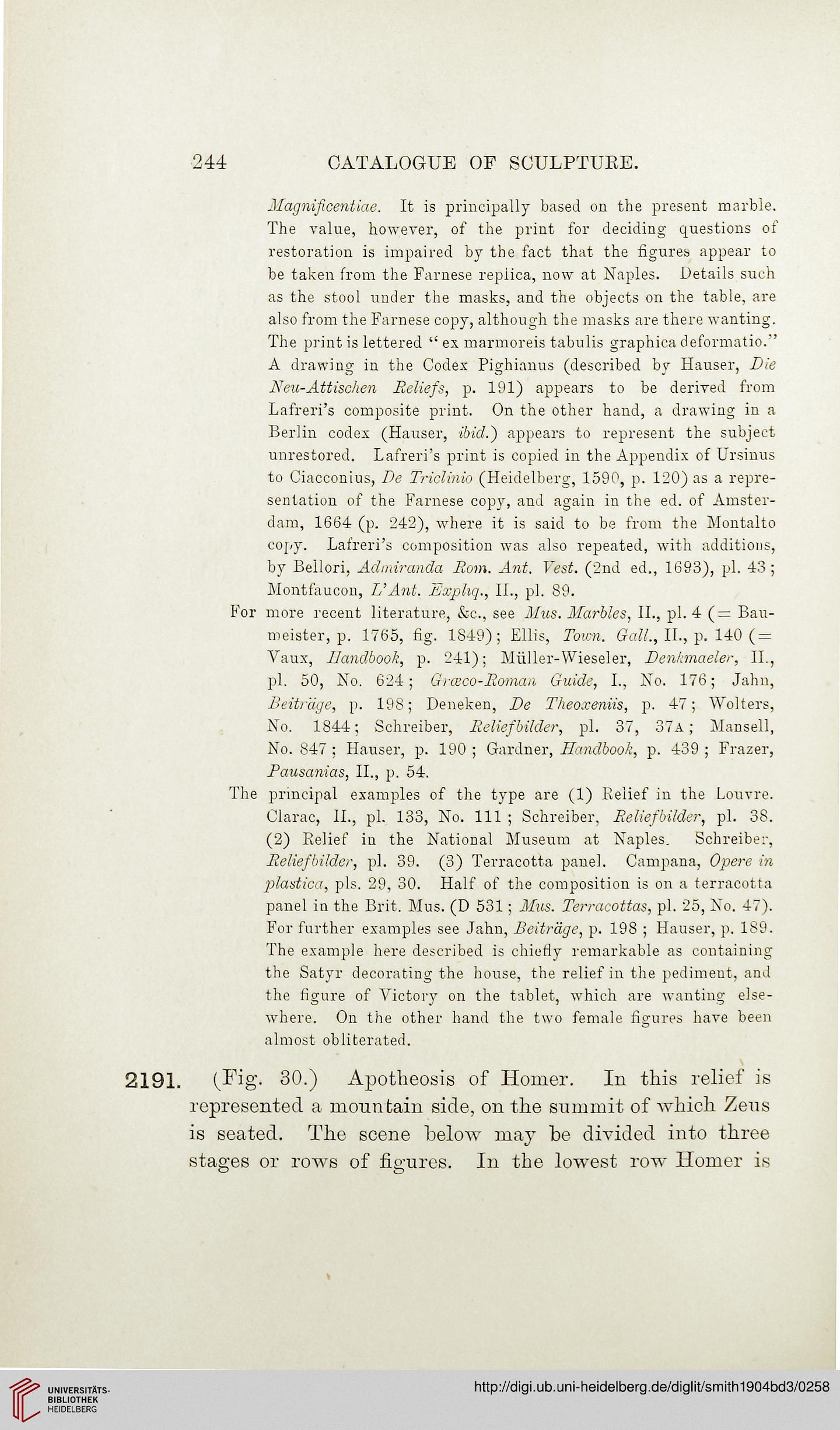244
CATALOGUE OF SCULPTUKE.
Magnificentiae. It is principally based on the present marble.
The value, however, of the print for deciding questions of
restoration is impaired by the fact that the figures appear to
be taken from the Farnese repiica, now at Naples. Details such
as the stool under the masks, and the objects on the table, are
also from the Farnese copy, although the masks are there wanting.
The print is lettered "exmarmoreis tabulis graphica deformatio.-'
A drawing in the Codex Pighianus (described by Hauser, Die
Neu-Attischen Reliefs, p. 191) appears to be derived from
Lafreri's composite print. On the other hand, a drawing in a
Berlin codex (Hauser, ibid.) appears to represent the subject
unrestored. Lafreri's print is copied in the Appendix of Ursinus
to Ciacconius, Be Triclinio (Heidelberg, 1590, p. 120) as a repre-
sentation of the Farnese copy, and again in the ed. of Amster-
dam, 1664 (p. 242), where it is said to be from the Montalto
copy. Lafreri's composition was also repeated, with additions,
by Bellori, Adtniranda Rom. Ant. Vest. (2nd ed., 1693), pi. 43;
Montfaucon, VAnt. Exphq., II., pi. 89.
For more recent literature, &c, see Mus. Marbles, II., pi. 4 (= Bau-
meister, p. 1765, fig. 1849); Ellis, Town. <7oK.t II., p. 140 (-
Vaux, Handbook, p. 241); Miiller-Wieseler, Denhmaeler, II.,
pi. 50, No. 624; Graco-Romaa Guide, I., No. 176; Jahn,
Beitrcige, p. 198; Deneken, Be Theoxeniis, p. 47; Wolters,
No. 1844; Schreiber, Reliefbilder, pi. 37, 37a; Mansell,
No. 847 ; Hauser, p. 190 ; Gardner, Handbook, p. 439 ; Frazer,
Bausanias, II., p. 54.
The principal examples of the type are (1) Relief in the Louvre.
Clarac, II., pi. 133, No. Ill ; Schreiber. Reliefbilder, pi. 38.
(2) Belief in the National Museum at Naples. Schreibe:-,
Reliefbilder, pi. 39. (3) Terracotta panel. Campana, Opere in
plastica, pis. 29, 30. Half of the composition is on a terracotta
panel in the Brit. Mus. (D 531; Mus. Terracottas, pi. 25, No. 47).
For further examples see Jahn, Beitrdge, p. 198 ; Hauser, p. 189.
The example here described is chiefly remarkable as containing
the Satyr decorating the house, the relief in the pediment, and
the figure of Victory on the tablet, which are wanting else-
where. On the other hand the two female figures have been
almost obliterated.
2191. (.Fig* 30.) Apotheosis of Homer. In this relief is
represented a mountain side, on the summit of which Zeus
is seated. The scene below ma}* be divided into three
stages or rows of figures. In the lowest row Homer is
CATALOGUE OF SCULPTUKE.
Magnificentiae. It is principally based on the present marble.
The value, however, of the print for deciding questions of
restoration is impaired by the fact that the figures appear to
be taken from the Farnese repiica, now at Naples. Details such
as the stool under the masks, and the objects on the table, are
also from the Farnese copy, although the masks are there wanting.
The print is lettered "exmarmoreis tabulis graphica deformatio.-'
A drawing in the Codex Pighianus (described by Hauser, Die
Neu-Attischen Reliefs, p. 191) appears to be derived from
Lafreri's composite print. On the other hand, a drawing in a
Berlin codex (Hauser, ibid.) appears to represent the subject
unrestored. Lafreri's print is copied in the Appendix of Ursinus
to Ciacconius, Be Triclinio (Heidelberg, 1590, p. 120) as a repre-
sentation of the Farnese copy, and again in the ed. of Amster-
dam, 1664 (p. 242), where it is said to be from the Montalto
copy. Lafreri's composition was also repeated, with additions,
by Bellori, Adtniranda Rom. Ant. Vest. (2nd ed., 1693), pi. 43;
Montfaucon, VAnt. Exphq., II., pi. 89.
For more recent literature, &c, see Mus. Marbles, II., pi. 4 (= Bau-
meister, p. 1765, fig. 1849); Ellis, Town. <7oK.t II., p. 140 (-
Vaux, Handbook, p. 241); Miiller-Wieseler, Denhmaeler, II.,
pi. 50, No. 624; Graco-Romaa Guide, I., No. 176; Jahn,
Beitrcige, p. 198; Deneken, Be Theoxeniis, p. 47; Wolters,
No. 1844; Schreiber, Reliefbilder, pi. 37, 37a; Mansell,
No. 847 ; Hauser, p. 190 ; Gardner, Handbook, p. 439 ; Frazer,
Bausanias, II., p. 54.
The principal examples of the type are (1) Relief in the Louvre.
Clarac, II., pi. 133, No. Ill ; Schreiber. Reliefbilder, pi. 38.
(2) Belief in the National Museum at Naples. Schreibe:-,
Reliefbilder, pi. 39. (3) Terracotta panel. Campana, Opere in
plastica, pis. 29, 30. Half of the composition is on a terracotta
panel in the Brit. Mus. (D 531; Mus. Terracottas, pi. 25, No. 47).
For further examples see Jahn, Beitrdge, p. 198 ; Hauser, p. 189.
The example here described is chiefly remarkable as containing
the Satyr decorating the house, the relief in the pediment, and
the figure of Victory on the tablet, which are wanting else-
where. On the other hand the two female figures have been
almost obliterated.
2191. (.Fig* 30.) Apotheosis of Homer. In this relief is
represented a mountain side, on the summit of which Zeus
is seated. The scene below ma}* be divided into three
stages or rows of figures. In the lowest row Homer is





